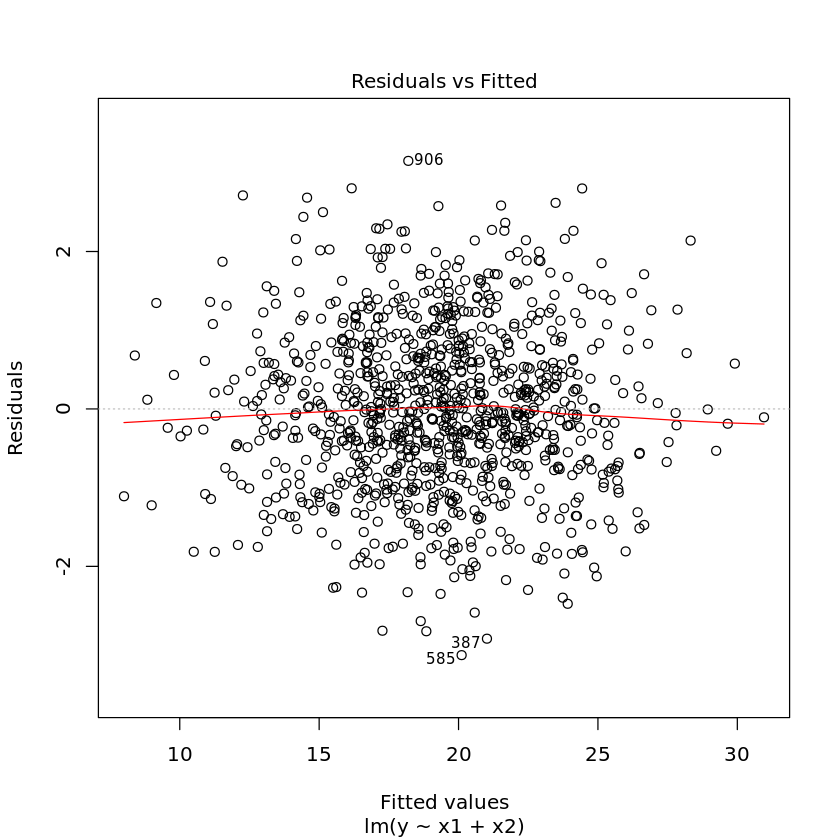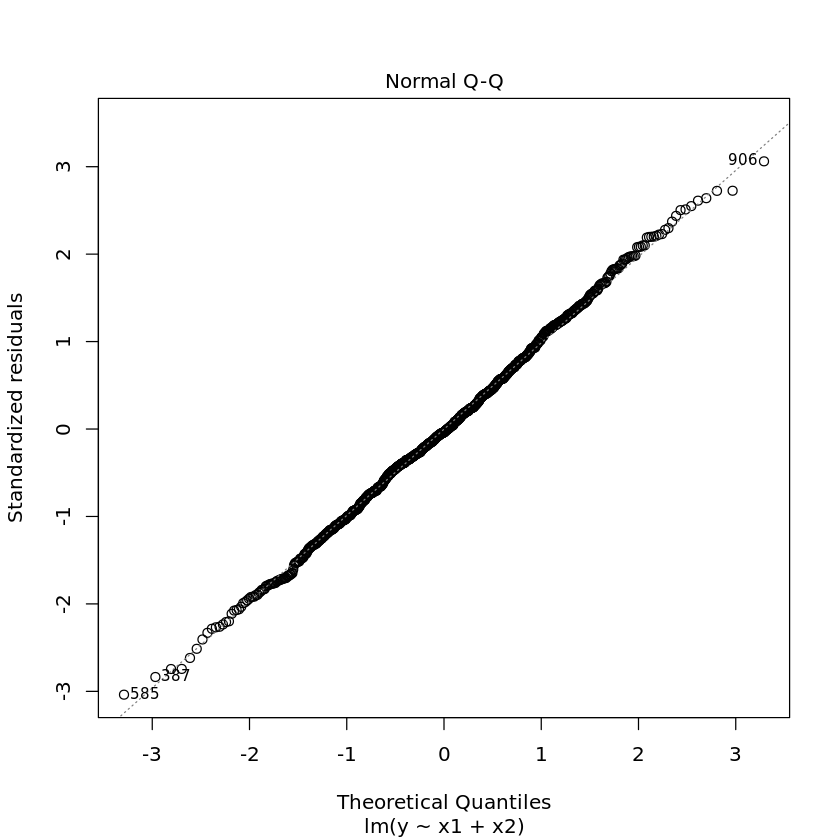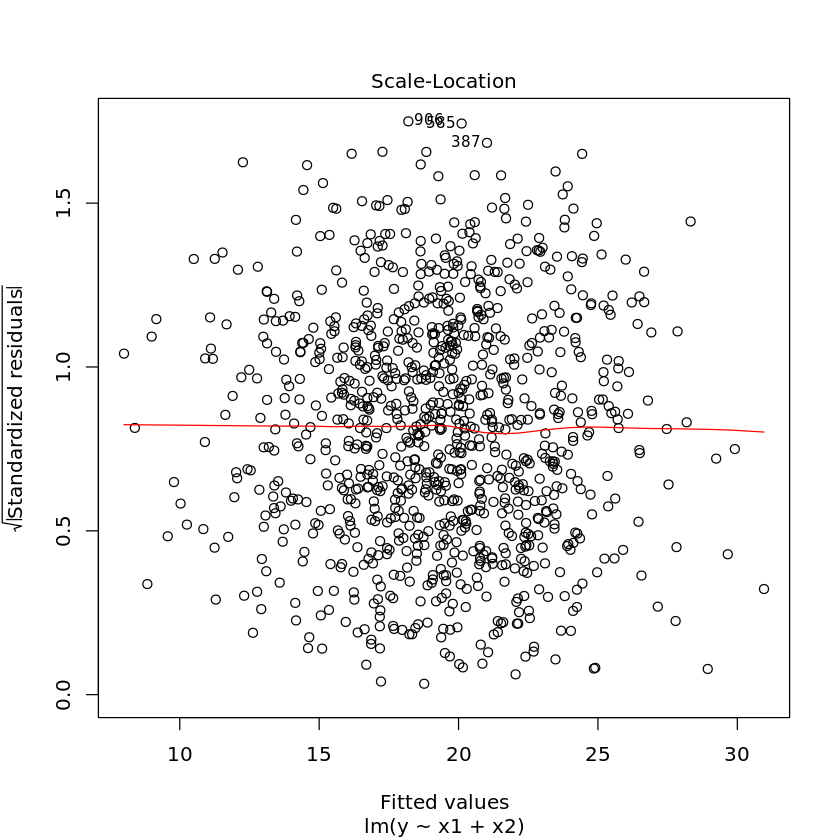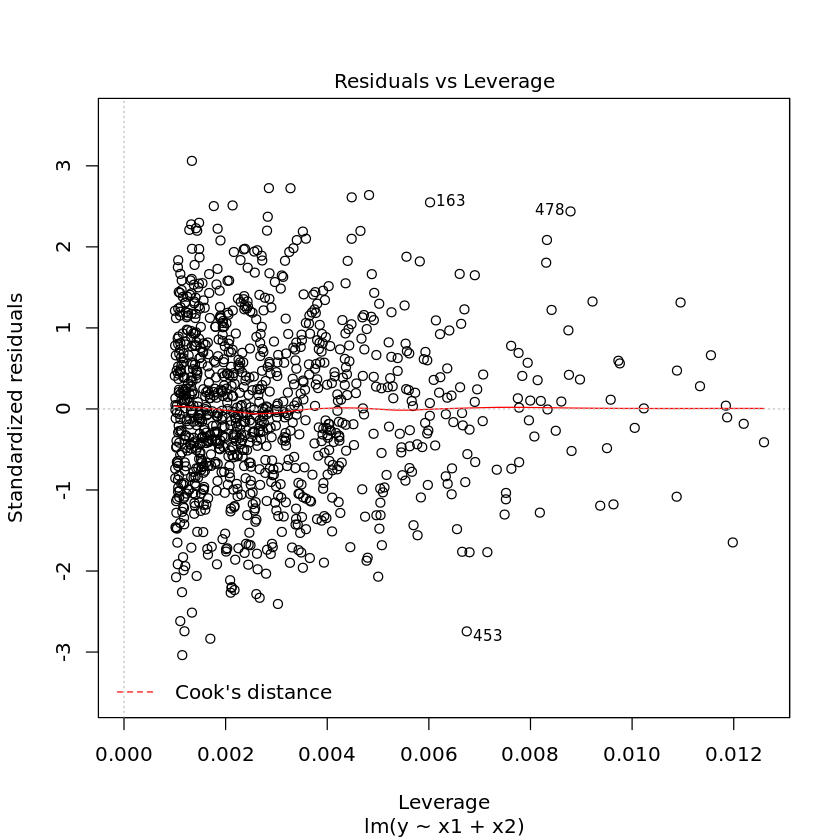1. Regression
[1]:
set.seed(37)
1.1. Simple regression
Below, we generate data.
\(X \sim \mathcal{N}(5, 1)\)
\(Y = 5.0 + 3.2X + \sigma\)
\(\sigma \sim \mathcal{N}(0, 1)\)
[2]:
N <- 100
x <- rnorm(N, mean=5, sd=1)
y <- 5 + 3.2 * x + rnorm(N, mean=0, sd=1)
df <- data.frame(x=x, y=y)
To perform the regression.
[3]:
df.lm = lm(y ~ x, data=df)
print(summary(df.lm))
Call:
lm(formula = y ~ x, data = df)
Residuals:
Min 1Q Median 3Q Max
-2.21229 -0.63914 -0.08198 0.60716 2.59378
Coefficients:
Estimate Std. Error t value Pr(>|t|)
(Intercept) 5.4522 0.4891 11.15 <2e-16 ***
x 3.1287 0.0975 32.09 <2e-16 ***
---
Signif. codes: 0 ‘***’ 0.001 ‘**’ 0.01 ‘*’ 0.05 ‘.’ 0.1 ‘ ’ 1
Residual standard error: 1.009 on 98 degrees of freedom
Multiple R-squared: 0.9131, Adjusted R-squared: 0.9122
F-statistic: 1030 on 1 and 98 DF, p-value: < 2.2e-16
To get the coefficients.
[4]:
c <- coef(df.lm)
print(c)
(Intercept) x
5.452218 3.128706
To get the confidence interval.
[5]:
c <- confint(df.lm, parm=c('(Intercept)', 'x'), level=0.9)
print(c)
5 % 95 %
(Intercept) 4.640068 6.264369
x 2.966801 3.290610
To get the fitted values of X using the learned model.
[6]:
f <- fitted(df.lm)
for (yPred in f[1:10]) {
print(yPred)
}
[1] 21.48607
[1] 22.29115
[1] 22.90803
[1] 20.1767
[1] 18.50409
[1] 20.05478
[1] 20.49454
[1] 25.36012
[1] 23.77378
[1] 21.77153
To get the residuals of the fitted values.
[7]:
r <- residuals(df.lm)
for (res in r[1:10]) {
print(res)
}
[1] 1.471064
[1] 1.531029
[1] -0.3335371
[1] 1.130025
[1] 2.593778
[1] -0.7148812
[1] 0.6899749
[1] 1.203087
[1] -0.2244655
[1] 1.70288
To plot the data with the best fit line.
[8]:
plot(y ~ x, data=df)
abline(df.lm)
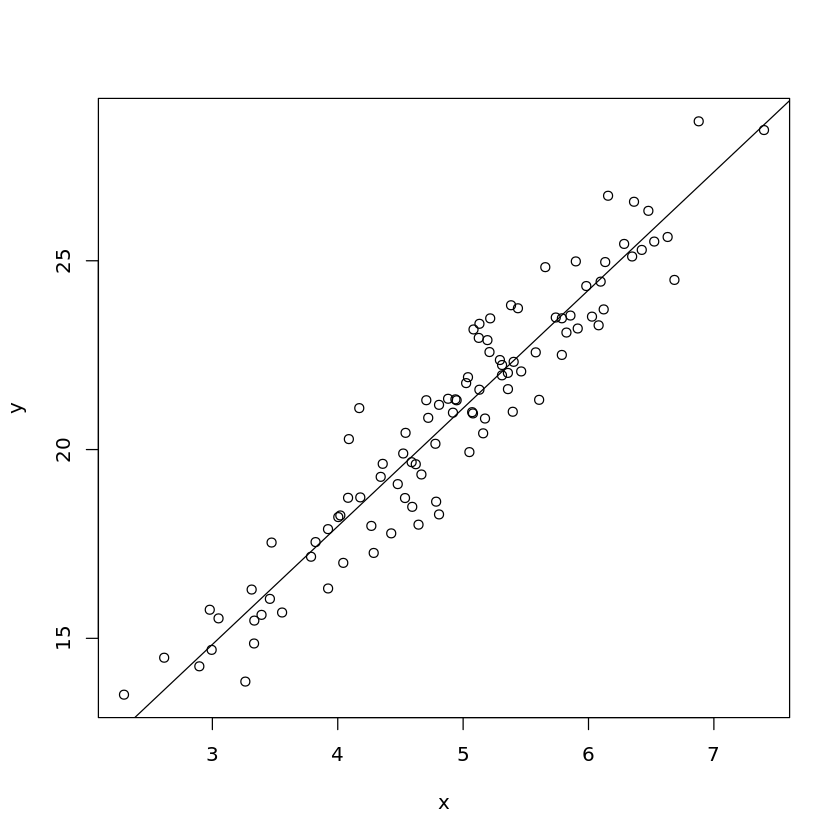
1.2. Multiple regression
Here we simulate data as follows.
\(X_1 \sim \mathcal{N}(5, 1)\)
\(X_2 \sim \mathcal{N}(2, 2)\)
\(Y = 5 + 3.2X_1 - 0.8X_2 + \sigma\)
\(\sigma \sim \mathcal{N}(0, 1)\)
[9]:
N <- 100
x1 <- rnorm(N, mean=5, sd=1)
x2 <- rnorm(N, mean=2, sd=2)
y <- 5 + 3.2 * x1 - 0.8 * x2 + rnorm(N, mean=0, sd=1)
df <- data.frame(x1=x1, x2=x2, y=y)
[10]:
df.lm = lm(y ~ ., data=df)
[11]:
s <- summary(df.lm)
print(s)
Call:
lm(formula = y ~ ., data = df)
Residuals:
Min 1Q Median 3Q Max
-2.16504 -0.69771 0.07134 0.64150 2.40497
Coefficients:
Estimate Std. Error t value Pr(>|t|)
(Intercept) 4.55549 0.43137 10.56 <2e-16 ***
x1 3.27409 0.08499 38.52 <2e-16 ***
x2 -0.78302 0.04806 -16.29 <2e-16 ***
---
Signif. codes: 0 ‘***’ 0.001 ‘**’ 0.01 ‘*’ 0.05 ‘.’ 0.1 ‘ ’ 1
Residual standard error: 0.9612 on 97 degrees of freedom
Multiple R-squared: 0.944, Adjusted R-squared: 0.9429
F-statistic: 818.2 on 2 and 97 DF, p-value: < 2.2e-16
[12]:
c <- coef(df.lm)
print(c)
(Intercept) x1 x2
4.5554927 3.2740864 -0.7830219
[13]:
c <- confint(df.lm, parm=c('(Intercept)', 'x1', 'x2'), level=0.9)
print(c)
5 % 95 %
(Intercept) 3.8391064 5.2718790
x1 3.1329343 3.4152384
x2 -0.8628321 -0.7032116
1.3. Comparing models
You may compare models using analysis of variance.
Here we simulate data as follows. Note that \(Y\) is not dependent on \(X_3\).
\(X_1 \sim \mathcal{N}(5, 1)\)
\(X_2 \sim \mathcal{N}(2, 2)\)
\(X_3 \sim \mathcal{N}(8, 1)\)
\(Y = 5 + 3.2X_1 - 0.8X_2 + \sigma\)
\(\sigma \sim \mathcal{N}(0, 1)\)
[14]:
N <- 1000
x1 <- rnorm(N, mean=5, sd=1)
x2 <- rnorm(N, mean=2, sd=2)
x3 <- rnorm(N, mean=8, sd=1)
y <- 5 + 3.2 * x1 - 0.8 * x2 + rnorm(N, mean=0, sd=1)
df <- data.frame(x1=x1, x2=x2, y=y)
[15]:
df.lm1 = lm(y ~ x1, data=df)
df.lm2 = lm(y ~ x1 + x2, data=df)
df.lm3 = lm(y ~ x1 + x2 + x3, data=df)
The interpretation below is that adding x2 to the baseline model improves the model but adding x3 does not.
[16]:
r <- anova(df.lm1, df.lm2, df.lm3)
print(r)
Analysis of Variance Table
Model 1: y ~ x1
Model 2: y ~ x1 + x2
Model 3: y ~ x1 + x2 + x3
Res.Df RSS Df Sum of Sq F Pr(>F)
1 998 3518.2
2 997 1058.2 1 2460.00 2316.9187 <2e-16 ***
3 996 1057.5 1 0.65 0.6126 0.434
---
Signif. codes: 0 ‘***’ 0.001 ‘**’ 0.01 ‘*’ 0.05 ‘.’ 0.1 ‘ ’ 1
1.3.1. Diagnostic plots
Diagnostic plots may also help you visually troubleshoot regression models. Simply use the plot command on the model.
[17]:
plot(df.lm2)
